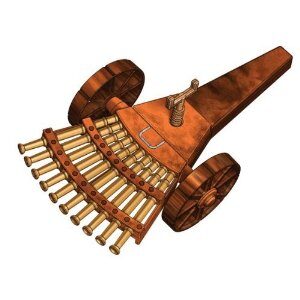
Leonardo da Vinci machine gun model
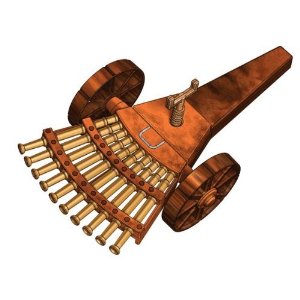

Leonardo da Vinci machine gun model
The Leonardo da Vinci machine gun is a fascinating example of ingenuity and foresight from the Renaissance era. You may find yourself intrigued by the idea of a famous artist contributing to weapons development.
This article will explore how Leonardo da Vinci’s imaginative designs paved the way for future advancements in weaponry.
Leonardo’s machine gun, also known as the 33-barreled organ, was a unique prototype that aimed to solve the slow reloading time of traditional firearms. By arranging multiple barrels in a fan shape, it allowed for rapid succession firing, which was groundbreaking for its time.
Though never built, Leonardo’s design was a precursor to modern automatic firearms.
Beyond just the machine gun, this inventive mind conceived various other war machines, including armored cars and giant crossbows. His work as a military engineer demonstrated his unparalleled ability to merge art with practical technology applications.
Enthusiasts of history and innovation will appreciate how his ideas influence designs in contemporary weapon systems.
Leonardo da Vinci’s inventive genius during the Renaissance led to many groundbreaking ideas. His concepts for military technology, such as the machine gun, showcased his imaginative approach to warfare.
During the Renaissance, Leonardo da Vinci emerged as one of the most influential figures in art, science, and engineering. His ideas often included significant advancements in technology.
The Leonardo da Vinci machine gun is a prime example of his foresight in modern weaponry. Developed in the 15th century, it proposed a rotating barrel system allowing continuous firing without reloading delays. This idea laid the groundwork for future advancements in artillery.
The Renaissance period was marked by a desire to explore new ideas, and da Vinci’s work reflected this spirit of innovation and curiosity. His visionary designs were not limited to weapons but also included concepts like the Leonardo da Vinci flying machine and the much-discussed Leonardo da Vinci tank.
Leonardo da Vinci’s military designs were ahead of their time, encompassing a range of da Vinci war machines. His work demonstrated a deep understanding of engineering principles, which he applied to create innovative solutions for military challenges.
Among his creations, the Leonardo da Vinci machine gun stood out for its unique approach. Featuring a 33-barreled organ gun, it aimed to improve firing rates and efficiency.
While these designs were revolutionary, they remained conceptual during his lifetime. This fascination with engineering extended beyond weapons, influencing later inventors and paving the way for future advancements in military technology.
Leonardo da Vinci’s machine gun showcases his remarkable ability to envision complex mechanical systems. This innovation foreshadowed the evolution of modern artillery and highlighted his forward-thinking approach to weaponry.
The da Vinci machine gun, often compared to the 33-barrel organ, was a marvel of engineering for its time. It featured multiple small-caliber barrels arranged in a fan shape, allowing for simultaneous firing. This design increased the rate of shots and offered a wide spread of bullets.
A crucial feature was its mobility. The gun’s carriage had wheels, enabling easy movement on the battlefield.
Leonardo’s sketches detailed loading mechanisms and the elevation adjustments necessary for aiming. The concept was to overwhelm enemies with a barrage of firepower, a strategy that still resonates in modern artillery systems.
Leonardo’s design was ahead of its time in terms of military technology. His war machines, like this machine gun, were part of a broader vision that included other ingenious inventions such as the Leonardo da Vinci tank and the parachute Leonardo da Vinci.
These devices underscore his understanding of the dynamics of war and defense mechanisms.
The concept of rapid-fire artillery, which was not fully realized until centuries later, highlights Leonardo’s pioneering thought. His machine gun laid the groundwork for future developments in weaponry.
Leonardo da Vinci’s machine gun exemplifies his visionary art, blending mechanics and aesthetics. His sketches reflect his innovative approach to engineering and showcase early ideas that predate modern firearms.
Within the Codex Atlanticus, Leonardo da Vinci created detailed machine gun designs featuring multiple barrels. This collection of drawings, part of the Biblioteca Ambrosiana in Milan, includes a 33-barreled organ gun resembling organ pipes aligned together. These sketches highlight his artistic finesse and his ability to envision warfare technology.
Da Vinci focused on machine guns and explored other military inventions, such as the Leonardo da Vinci cannon and various war machines. His designs were intended to improve firing rates in conflict situations.
Though his machine gun concept was never built, it paved the way for modern engineering discussions.
Leonardo’s work exhibits a seamless fusion of art and science. His drawings stand as artistic representations that reveal his unique perspective on innovation. This blend of creativity and engineering showcases da Vinci’s profound impact on art and technology.
Recreating Leonardo da Vinci’s machine gun involves understanding and adapting his original designs for modern construction. This task appeals to history enthusiasts and engineers who appreciate da Vinci’s ingenuity.
Leonardo da Vinci’s machine gun, sometimes called a rapid-fire crossbow, was detailed in his famous notebook, the Codex Atlanticus. Enthusiasts and historians have recreated this design to explore its practicality. The machine gun aimed to fire multiple shots rapidly, an idea unique to da Vinci’s time.
Producing this machine includes using materials and methods that mirror the 16th-century vision.
The Leonardo3 Museum provides insights into these machines by displaying digital and physical models.
Their exhibits allow visitors to interact with da Vinci’s concepts, ranging from crossbow designs to flying machines. Building these models deepens our appreciation for his inventive genius and showcases how his ideas, such as the Leonardo da Vinci machine gun, remain significant advancements in engineering.
Leonardo da Vinci’s machine gun designs showcase his remarkable foresight and creativity in weapon innovation. His concept of a multi-barreled weapon addressed the slow reloading times of early firearms.
Several of his designs, like the 33-barreled organ gun, can be seen as prototypes for modern artillery.
Leonardo’s innovative use of multiple cannons firing in succession demonstrated his deep understanding of battlefield needs.
Despite their potential, these designs mainly remained theoretical due to technological and resource constraints. However, his ideas did influence later generations.
Key Takeaways: Leonardo da Vinci’s ideas on machine guns were ahead of his time, laying the groundwork for future advancements in rapid-fire weaponry. His inventive spirit continues to inspire engineers and inventors today.
Leonardo da Vinci’s interest in military technology led him to create designs for various machines. His designs include a machine gun concept known as the 33-barreled organ, but many of his inventions faced challenges in practicality and execution.
Leonardo da Vinci designed a concept for a machine gun called the 33-barreled organ. This design featured multiple barrels arranged in rows to allow rapid firing. However, he never actually built a functioning model.
The 33-barreled organ was an ambitious design never constructed in da Vinci’s time. The technology and materials available during the Renaissance were insufficient to bring this design to life. However, it remains a concept that demonstrates his innovative thinking.
Leonardo da Vinci did not invent the ballista, as it was an ancient missile weapon the Greeks and Romans used. However, he did create designs that improved upon the existing ballista technology. His version featured enhancements for increased power and accuracy.
Leonardo da Vinci designed various military machines, including a tank, a giant crossbow, and a machine gun. He also conceptualized an armored vehicle resembling a modern tank. These designs showcased his creativity and vision for military innovation.
Many of Leonardo da Vinci’s military machines remained conceptual and were not built during his lifetime. Practical limitations and the complexity of his designs often prevented them from being realized.
Leonardo’s catapult design used tension to launch projectiles. It featured a sling that held the projectile, which was then launched by releasing the tension in a coiled rope or spring. This design aimed to enhance the range and power of traditional catapults.
Leonardo da Vinci is credited with designing a mechanical knight, often regarded as one of the earliest robots. This machine could mimic human motions, such as sitting, standing, and moving its arms. However, it was not built during his lifetime.
Leonardo da Vinci did not invent the grenade, but he did sketch designs for explosive devices. One of his ideas was a cylindrical grenade filled with powder. This illustrates his interest in and contributions to early warfare concepts.
Leonardo da Vinci sketched a design for a flying machine known as the “aerial screw.” This design resembled a primitive helicopter with a sizeable screw-shaped rotor. Though it was never built, it was an early exploration of vertical flight.
Leonardo da Vinci’s tank design was made of wood and featured a protective shell reinforced with metal plates. The vehicle was equipped with various cannons and designed to move on wheels. However, mechanical limitations prevented it from being built.
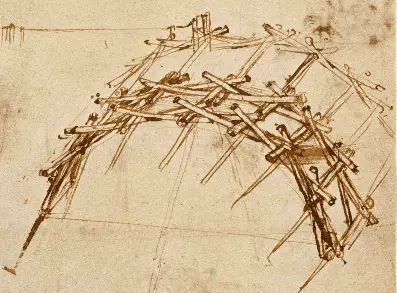
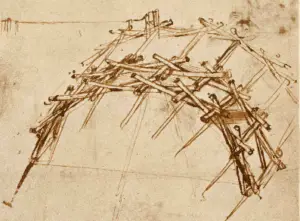
Leonardo da Vinci self-supporting bridge is an engineering marvel from the Renaissance. Unlike traditional bridges, it doesn’t need nails, ropes, or fasteners.
It stands purely through balance and clever design. This bridge captures Leonardo’s ability to merge art, science, and functionality in a single masterpiece.
The bridge works by using tension and compression. Logs or beams interlock to create an arch that supports itself. Each piece presses against its neighbors, holding the whole structure together.
This approach distributes weight evenly, eliminating the need for additional support materials.
Leonardo mastered geometry and natural forces to create this design. He carefully calculated each angle and placement.
His work demonstrates his profound understanding of the world around him, encompassing anatomy and flight.
Leonardo created this bridge while working as a military engineer for Cesare Borgia. His goal was to help troops cross rivers quickly and safely.
The bridge could be assembled fast, carried efficiently, and dismantled after use. This gave armies a considerable advantage.
Leonardo’s connection to the Medici family also supported his bold ideas. He saw bridges not just as military tools but as symbols of connection and progress.
Leonardo even designed a giant bridge for the Golden Horn in Istanbul. Though it was never built, it showed his forward-thinking approach. His ideas would inspire architects and engineers for centuries to come.

Leonardo never built the original bridge himself. But today, people around the world have brought his vision to life. The full-scale pedestrian bridge in Ås, Norway, finished in 2001, proves that his design works in reality.
Museums and science centers often feature smaller models. These hands-on displays help people of all ages understand how the bridge stands. Some universities use it to teach future architects and engineers about simplicity and balance.
Building a Da Vinci bridge at home or in the classroom is fun and educational. You can use popsicle sticks, pencils, or even wooden dowels.
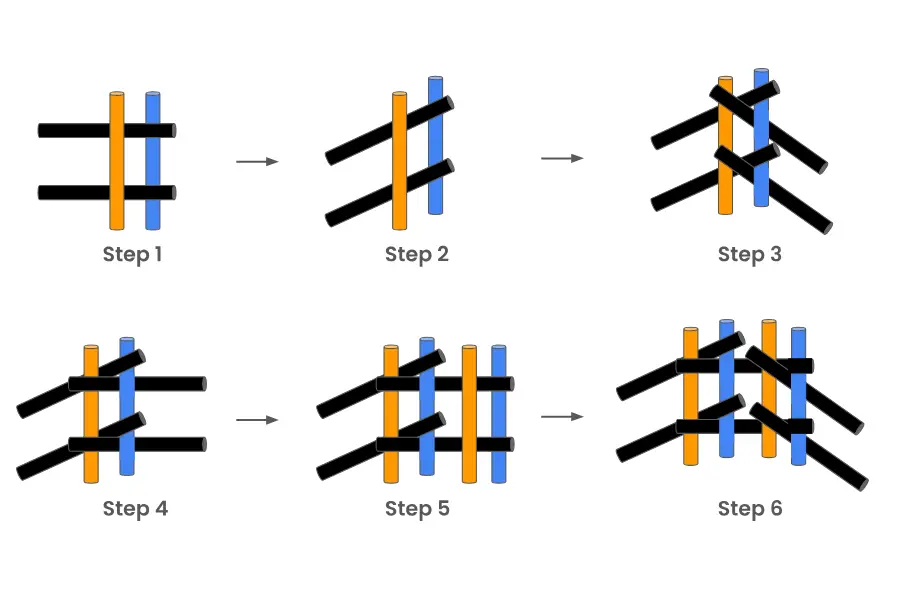
Place four popsicle sticks on a flat surface, parallel and evenly spaced. In your guide, these are shown with the orange side up and the blue side down to help visualize orientation.
Gently lift the parallel sticks slightly off the surface. This begins creating the arch shape and allows weaving to start smoothly.
From the right side, weave two black popsicle sticks through the lifted structure. These sticks secure the base together and form the first layer of crossing.
Carefully lift the structure higher to create space and tension for the next set of sticks. This helps stabilize the early framework.
Place two additional popsicle sticks on top, parallel to the original base sticks, with the same orange side up and blue side down. This starts creating the layered arch.
From the right side again, insert two more black sticks, weaving them through the new parallel sticks. By this point, the structure should start to hold itself — this is the self-supporting stage.
Repeat Steps 5 and 6 as many times as you’d like to extend the bridge. Each additional layer makes it longer and stronger.
Once your bridge stands on its own, carefully test it by placing small objects on top of it. Watch how the forces distribute and adjust if needed. Try different lengths or angles to explore how the design changes.
Download our free step-by-step illustrated PDF guide to build your own Da Vinci bridge at home or in class!
Leonardo’s bridge helps students learn about balance, geometry, and design thinking. By building it, they see how forces work together to create stability.
In real-world engineering, his principles inspire the rapid assembly of bridges used during emergencies or military operations. Modern architects also borrow from his focus on simplicity and natural strength.
His design even connects to modular and prefabricated construction methods today. Over 500 years later, Leonardo’s ideas still guide engineers and architects.
The Da Vinci bridge is more than an engineering feat. It’s an artistic statement. Its graceful arches and clean lines reflect Renaissance ideals of harmony and beauty.
Artists and architects use this form in modern sculptures and public installations. The bridge symbolizes connection, resilience, and the endless potential of human creativity.
Leonardo called it the “Bridge of Safety.” The da Vinci Bridge was just one of the ingenious structures he had designed throughout his life.
He also invented several other bridges, including a revolving bridge that, according to Leonardo da Vinci, “could be quickly packed and transported to enable fleeing armies to cross waters,” “cross streams or moats, put the bridge on the other side for easy passage of soldiers” and “fitted with a system of ropes and pulleys for quick deployment and easy transport.”
These tools are helpful for those who once aspired to military supremacy in Italy, but they are more useful for 21st-century Renaissance individuals.
One of Leonardo da Vinci’s most famous architectural designs is a bridge spanning the Golden Horn in Istanbul, Türkiye.
The Golden Horn played a significant role in the Ottoman Empire. In the late 15th century, Sultan Bayezid II asked Leonardo da Vinci to design a bridge over the harbor.
Inspired by the beauty and importance of the Golden Horn, Leonardo da Vinci envisioned a functional, aesthetically pleasing, sturdy, and graceful bridge with a simple and elegant design.
Despite its simplicity, the design was highly innovative. It used a series of arches and buttresses to support the bridge, which would have made it one of the most stable bridges of its era.

Unfortunately, the design was never built, but modern engineering and technology have made it possible to construct Leonardo da Vinci’s bridge design today, allowing us to appreciate its genius.
The Golden Horn bridge design (Leonardo da Vinci’s self-supporting bridge design) inspires architects and engineers worldwide, setting a high standard for bridge design that continues to influence the field.
The Da Vinci Bridge is known for its innovative and unconventional design. Unlike traditional bridges, which rely on solid supports and multiple structural elements, this bridge is a self-supporting arch made entirely from interlocking wooden planks.
Its simplicity and elegance make it a remarkable feat in both engineering and architecture.
The bridge’s design is based on the principle of compression and tension forces. The self-supporting arch distributes the bridge’s weight evenly, utilizing the structure’s inherent strength.
The forces are balanced by precisely arranging the planks, allowing the bridge to stand without external support.
Although Leonardo da Vinci is renowned for his drawings and sketches of the bridge, there is no historical evidence that he constructed it himself.
However, his detailed drawings and concepts demonstrate his deep understanding of engineering and ability to envision groundbreaking structures.
One of the surviving replicas of the da Vinci bridge can be found in the town of Ås, Norway.
The bridge, built in 2001, is a testament to its lasting legacy. It is based on Leonardo’s original design.
The strength of the da Vinci bridge lies in its unique geometric design. The interlocking structure distributes the weight evenly, enabling the bridge to withstand heavy loads.
The arch shape and the compression forces along the curved structure ensure its stability and resilience.
One of Leonardo da Vinci’s most fascinating aspects is his ability to bridge the gap between art and science. He was a masterful painter, a prolific inventor, an engineer, and an anatomist.
His insatiable curiosity and passion for knowledge allowed him to make groundbreaking contributions in various fields, leaving an indelible mark on history, as supported by his famous quotes.
Leonardo da Vinci’s design for the Golden Horn Bridge in Istanbul, Türkiye, has had a profound impact on modern bridge engineering. Although it was created over 500 years ago, it remains relevant and inspiring to engineers today.
Leonardo da Vinci’s innovative use of arches and buttresses to support the bridge was ahead of its time. It helped set a standard for bridge design that continues to influence the field.
Leonardo da Vinci’s principles of stability and simplicity, which he applied in his bridge design, remain influential in modern bridge construction worldwide.
Today’s engineers have built upon Leonardo da Vinci’s ideas and incorporated new materials and technologies to create stronger, more durable bridges.
Leonardo da Vinci faced numerous challenges when designing his bridge for the Golden Horn in Istanbul, Turkey. One of the primary challenges was to create a bridge that was both functional and aesthetically pleasing.
The Golden Horn was a vital waterway in the Ottoman Empire, and the bridge accommodated both pedestrian and horse-drawn traffic, while also serving as an attractive landmark.
Another challenge was the limited technology and materials available at the time. Unlike modern engineers, who have access to advanced technologies such as computer-aided design (CAD) and materials like steel and concrete, Leonardo da Vinci had to rely on his knowledge and intuition to create a design that would be both stable and durable.
Leonardo da Vinci’s bridge design for the Golden Horn in Istanbul, Türkiye, has been preserved and celebrated in several ways. Even though the design was never actually built, it remains one of Leonardo da Vinci’s most famous and revered works.
In the centuries following his death, his plans were rediscovered and studied, and today they are widely regarded as some of the most significant architectural designs in history.
The legacy of Leonardo da Vinci’s bridge design has been preserved through books, exhibitions, and digital archives. Numerous books and exhibitions have showcased the design and explored its significance in the fields of engineering and architecture.
In recent years, digital archives have allowed people worldwide to access and study Leonardo da Vinci’s bridge design efficiently. This will enable them to appreciate the genius of his work and understand its impact on the field.
Additionally, efforts have been made to build full-scale models and replicas of the design, which help demonstrate its functionality and highlight its innovative features.
Leonardo da Vinci’s bridge design for the Golden Horn remains a pivotal piece of history and continues to inspire architects and engineers worldwide.
Advances in technology have made it possible to construct Leonardo da Vinci’s bridge design for the Golden Horn in Istanbul, Türkiye, today. Modern engineering techniques and materials have significantly expanded the capabilities of bridge construction, enabling engineers to bring Leonardo da Vinci’s designs to life in a manner previously impossible.
New materials, such as advanced composite materials and high-strength steel, enhance durability and stability. At the same time, computer-aided design and simulations enable engineers to test and optimize designs for optimal performance.
Additionally, modern construction techniques have made building large, complex structures, such as bridges, easier. Advances in crane technology, for example, have allowed engineers to build bridges that are both taller and longer than ever before.
Prefabricated components and modular construction methods have also enabled the faster and more efficient construction of bridges, resulting in less waste.
These technological advancements have enabled engineers to construct a bridge design inspired by Leonardo da Vinci’s for the Golden Horn with greater precision and efficiency, ensuring its stability and longevity for future generations.
Leonardo’s bridge is just one example of his genius. His sketches also include flying machines, anatomical studies, and clever mechanical devices. Each idea shows his love for blending science and art.
Explore more on our Leonardo da Vinci Inventions page. You can also check out Smithsonian Magazine and The British Museum for more in-depth explorations of his life and work.
The Da Vinci bridge remains a testament to Leonardo da Vinci’s remarkable vision and ingenuity. Through his designs, he introduced concepts that were centuries ahead of their time.
His ideas inspire modern engineers who explore historical innovations to solve contemporary problems.
Leonardo’s self-supporting bridge design showcases his profound understanding of architectural principles and natural forces. This structure offers insight into his skillful application of geometry, balance, and aesthetics.
The self-supporting bridge exemplifies his innovative approach to problem-solving.
The unbuilt superlong Istanbul bridge that da Vinci imagined demonstrated his ambitious thinking. Recent studies have shown that this design could have worked even with the materials available in his era.
This feat highlights the timeless nature of his genius.
Key Features of the Da Vinci Bridge:
Today, replicas and studies of da Vinci’s bridges continue to serve educational purposes. They provide valuable lessons in engineering, showcasing the power of creativity and foresight.
These structures inspire a new generation of thinkers and creators.
Da Vinci’s influence extends beyond art into engineering and architecture. While often unrealized during his lifetime, his bridges continue to motivate ongoing exploration and understanding of innovative engineering solutions.
The bridge thus symbolizes a bridge between past and present, carrying forth the legacy of creativity and inventiveness.
The Da Vinci Bridge is known for its innovative design and structural capabilities. It showcases Leonardo da Vinci’s remarkable engineering skills and the clever use of physics.
The Da Vinci Bridge is unique because it is self-supporting. That means it holds itself together without the need for nails or ropes. It relies on the tension between its components to remain stable.
While the exact weight it can support varies, the structure is renowned for its strength, enabling it to support a significant amount of weight for its size and design.
The strength comes from its design, where pieces interlock in a way that distributes weight evenly. This unique arrangement provides stability and resilience.
The magic lies in its clever use of tension and compression. The bridge features interlocking beams that create a stable structure purely through geometric principles.
Leonardo da Vinci was a visionary who made significant contributions to the arts and sciences. His diverse inventions and designs, such as the self-supporting bridge and paintings like the Last Supper, highlight his vast talents.
The bridge uses a simple interlocking mechanism. Wooden beams intersect, creating stability through tension and compression.
Unlike the Da Vinci bridge, famous for its engineering, the u0022Devil’s Bridgeu0022 typically refers to European bridges with mythical lore. Each has unique architectural features that contribute to its distinct appearance.
The background of the Mona Lisa probably includes the Ponte Buriano Bridge, a stone structure in Italy.
The Golden Gate Bridge in San Francisco, constructed during the Great Depression, is renowned for its impressive engineering and iconic design.
The Cambridge Mathematical Bridge is known for its precise design. Although it looks curved, it is made of straight timbers, a testament to the power of mathematics in engineering.
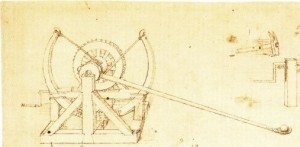
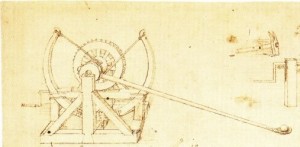
Leonardo da Vinci Catapult is an intriguing invention. Its design stands out because it combines artistic creativity with scientific precision. The catapult featured a leaf-spring system and a rotating drum mechanism, enhancing the power and efficiency of traditional catapults.
Leonardo da Vinci‘s innovative approach to warfare and defense fascinates those who are curious about the future applications and impacts of his catapult.
His designs significantly influenced military technology and made notable contributions to the broader engineering field. The Leonardo da Vinci Catapult enables visitors to delve more deeply into these revolutionary concepts.
This invention is a testament to da Vinci’s forward-thinking mindset, reflecting his unique perspective on the relationship between form and function.
Studying his improvements to this device reveals the extensive knowledge and creativity he applied to his work.
Leonardo da Vinci, a renowned figure of the Renaissance, made significant contributions to science and engineering. His inventions, such as the Leonardo da Vinci Catapult, reflect the era’s interest in military advancements and innovation.
Europe experienced a surge in cultural, scientific, and technological progress during the Renaissance. This period was characterized by a renewed interest in classical knowledge and a desire to innovate. Military technology also saw significant advancements during this time.
The ancient Greek catapults had been used for centuries, but their designs evolved. Leonardo da Vinci, intrigued by these ancient mechanical devices, developed his version.
The Leonardo da Vinci Catapult improved upon previous designs by incorporating innovative features that increased its power and range.
Military engineering was critical during the Renaissance, as conflicts and territorial expansions were rampant. Da Vinci’s work stood out because he combined his artistic skills with practical engineering, resulting in sophisticated designs that were ahead of their time.
Extensively studied catapult models provide insight into his genius and the technological capabilities of the period.
Leonardo da Vinci’s role extended beyond that of an artist. He was also a visionary engineer and inventor. He applied his understanding of mechanics and physics to create artistic and functional designs.
Da Vinci’s inventive genius is evident in designs like the armored vehicle and the Leonardo da Vinci Catapult. Though many of his inventions were not built during his lifetime, they influenced later developments in engineering. Leonardo’s notebooks reveal detailed sketches and ideas that often blended creativity with scientific exploration.
His ability to envision machines like the catapult, which he innovatively designed to suit the needs of his time, showcases his impact. Leonardo’s legacy as an engineer has left an indelible mark on technological advancements, inspiring generations of inventors.
Leonardo da Vinci’s catapult showcases his ingenuity in reimagining medieval catapult design with improved efficiency and power. By studying existing mechanics, he aimed to enhance projectile launching by exploring innovative materials and mechanisms.
Leonardo da Vinci created detailed sketches and notes demonstrating his visionary approach to catapult design. Although his catapult was not an entirely new invention, he sought to refine existing concepts through thoughtful adjustments. One of his designs included a double-leaf spring mechanism, allowing increased tension and power.
His sketches were precision-oriented, taking into account force vectors and projectile trajectories. Careful calculations ensured stability and balance, which is vital for an effective launch. Although his designs were not built during his lifetime, they offer insight into his mechanical brilliance and forward-thinking approach.
Leonardo da Vinci’s catapult’s core mechanics revolved around tension and torque-enhancing launching force. Unlike traditional torsion-based catapults, it utilized a spring leaf mechanism. This adjustment enabled more controlled and powerful launches, thereby increasing the range and impact of projectiles.
Leonardo also focused on improving the loading and firing mechanism, aiming to simplify the process and make it more efficient for potential wartime use.
His understanding of torque and tension motivated this enhancement, ensuring each component worked symmetrically. As a result, da Vinci’s catapult demonstrated artistic prowess and a sophisticated understanding of engineering principles.
Leonardo da Vinci’s catapult showcases the innovative use of materials and construction techniques. Its design reflects a blend of wood and rope preferences, and its unique approach to tension and counterweight systems enhanced its efficiency as a war machine.
Leonardo da Vinci’s catapult relied on carefully selected wood and rope, which were vital for its functionality. Hardwoods like oak were preferred for their durability and strength, which is essential for withstanding the stress of launching projectiles. Softwoods, despite being lighter, were less common in such applications.
Ropes made from natural fibers, such as hemp, were both flexible and strong. Hemp’s elasticity was crucial for efficiently absorbing and releasing energy during the firing process. The combination of hardwood for structural components and hemp for tension elements ensured a balance between strength and flexibility, thereby maximizing the power and range of the projectiles.
Leonardo da Vinci’s approach to tension and counterweight systems in his catapult design was distinctive. These mechanisms were crucial for the catapult’s ability to launch projectiles.
By optimizing the tension in the ropes and employing counterweights, the da Vinci catapult could achieve significant force and distance.
Tension was carefully adjusted by winding ropes, a method derived from earlier torsion-based catapults, such as the ancient Greek models. This tension-powered mechanism allowed controlled and precise releases, while counterweights provided the necessary balance to maintain stability during operation.
This integrated system of tension and counterweights exemplifies Leonardo da Vinci’s ingenuity. He combined ancient catapult principles with his inventive enhancements, and this thoughtful design and construction enabled his catapult to perform effectively as a formidable weapon at the time.
Leonardo da Vinci’s innovative designs transformed the landscape of military technology. His work on war machinery, such as the da Vinci catapult, provided fresh insights into the capabilities and mechanisms of siege engines.
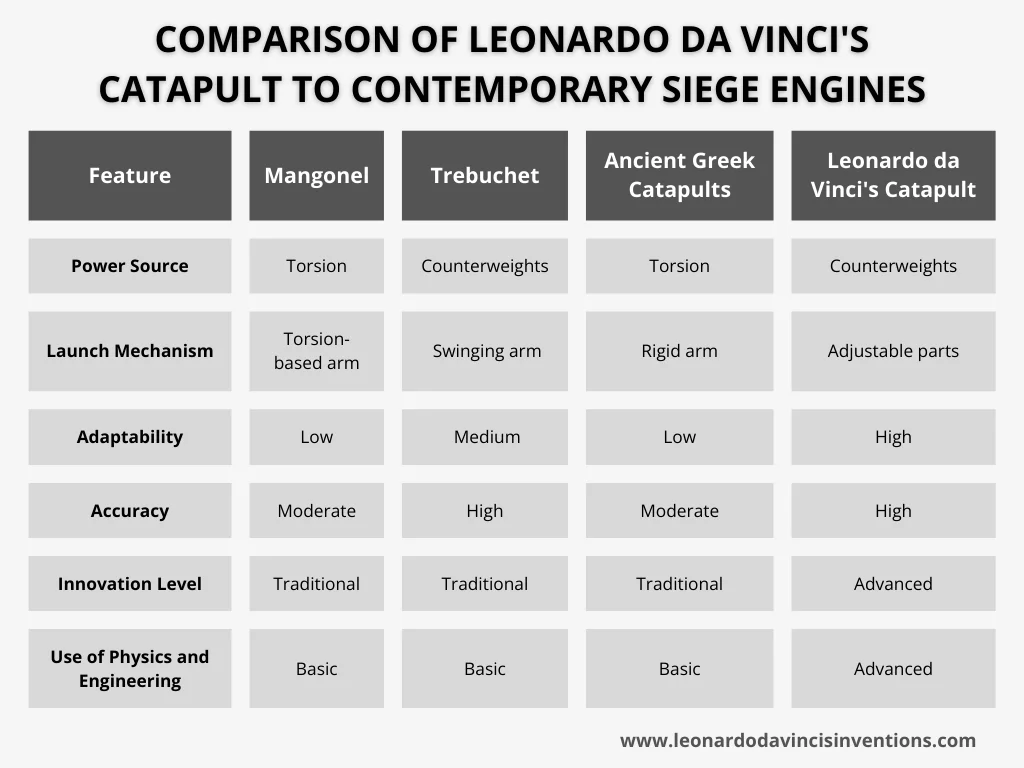
Leonardo da Vinci’s contributions extended beyond weaponry, influencing the broader field of military engineering. His sketches, which included detailed mechanisms and structural designs, inspired future generations to explore new engineering possibilities.
The da Vinci catapult showcased how art and science could converge to improve military technology. His emphasis on precision and efficiency paved the way for modern engineering strategies used in warfare.
By focusing on practicality alongside creativity, da Vinci’s inventions encouraged a shift from brute force to more calculated and efficient methods of attack, altering the course of military strategy development. His work on siege engines remains a testament to his profound impact on military design and engineering.
The question of who invented the catapult takes us back to the ancient world. The first known catapults were developed in ancient Greece in the 4th century BC, specifically by a Syracuse engineer named Dionysius the Elder.
Unlike the da Vinci catapult, these early devices relied on torsion power from twisted ropes or sinew rather than tension or counterweights. This type of catapult, also known as a mangonel catapult, used the stored energy in the twisted ropes to hurl projectiles toward the enemy.

As centuries passed, the design blueprints of catapults underwent significant changes. Greek and Roman engineers refined and diversified catapult designs, introducing new mechanisms like the ballista and onager.
It’s fascinating to compare these classical designs with the more sophisticated da Vinci catapult, a testament to the evolution of engineering over the millennia.

In East Asia, the Mongols advanced catapult technology by developing the Mongolian catapult, also known as the Hwacha. This innovation could fire multiple projectiles at once, a stark contrast to the single-projectile designs common in the West.
Catapult technology saw another shift during the Middle Ages. The most prominent type of catapult used during this period was the trebuchet. This siege weapon used a counterweight mechanism, unlike the tension-based design of the da Vinci catapult.

Trebuchets were the apex of medieval siege technology, capable of hurling large projectiles at great distances. The introduction of counterweight technology marked a significant departure from the ancient torsion catapult design, leading to more powerful and efficient siege engines.
Despite the differences in design and the centuries that separate them, the trebuchet and Leonardo da Vinci’s catapult share a common purpose: to utilize mechanical advantage to achieve power and precision beyond human capabilities.
Here are five fun facts about catapults that might surprise you:
There are 4 Leonardo da Vinci catapult facts that might not be commonly known:
In contrast to their original role as siege engines, the uses of catapults in modern times are remarkably diverse. The physics principles that catapults employ have found applications in various modern technologies:

Modern efforts to recreate Leonardo da Vinci’s catapult bridge the past and the present. These reconstructions offer practical insights into historical siege technologies and engaging educational experiences for learners.
Enthusiasts and historians today are captivated by the task of bringing da Vinci’s catapult to life. They aim to precisely replicate da Vinci’s intricate designs using advanced techniques such as 3D printing and laser cutting. Instructables details the steps to construct these models, making them accessible to hobbyists and educators.
These projects highlight da Vinci’s work’s elegance while showcasing improvements in design and function over traditional catapult weapon systems. These reconstructions show a clear link between ancient engineering concepts and modern manufacturing capabilities.
Da Vinci catapult replicas serve as valuable educational tools, bringing to life the history of catapults and connecting students with ancient technologies and the evolution of military strategies.
Schools and museums often use these models to teach physics and engineering principles. Through hands-on interaction, tension, force, and trajectory become tangible.
For children and students, working with these replicas fosters curiosity. Educational resources, such as those found on Teaching Expertise, provide activities that nurture creative thinking by marrying historical context with scientific understanding. This makes learning about the catapult’s ancient Greek origins and its application in warfare both entertaining and informative.
Leonardo da Vinci’s catapult is a testament to his endless curiosity and genius. His variations on the traditional catapult design showed his willingness to rethink and improve upon existing technologies.
These improvements highlighted his interest in mechanics and physics, which were ahead of their time.
Leonardo explored various concepts, such as using leaf springs to enhance throwing power.
These sketches demonstrated his understanding of torque and tension forces, paving the way for more dynamic catapult designs.
Though da Vinci’s catapult designs were not widely adopted during his lifetime, they contributed to technological progress and revealed his innovative spirit.
This aspect of his work reflects his approach to numerous inventions, where creativity and science intersect.
Key Takeaways:
Leonardo’s fusion of art and science continues to inspire modern engineering and design, offering insights that remain relevant today.
Catapults have fascinated people for centuries, from ancient war machines to innovative designs by geniuses like Leonardo da Vinci.
These devices illustrate the evolution of engineering, highlighting various types and their historical significance.
The ancient Greeks initially invented the catapult, specifically by a Syracuse engineer named Dionysius the Elder. They developed it in the Fourth Century BCE to enhance their siege warfare techniques.
The first known catapults were invented around 399 BCE. They revolutionized how armies conducted sieges during battles.
A catapult stores potential energy in a tension arm or through the twisting of a rope. This energy propels a projectile across long distances with great force when released.
The Greeks are credited with inventing the catapult around 399 BCE. This invention provided a major advantage in warfare at the time.
The mangonel catapult was developed in the early Middle Ages, around the 6th century. It was designed to use torsion and tension to produce maximum force.
The trebuchet, which emerged in the 12th century, is regarded as one of the most formidable medieval siege engines. It used a counterweight system to hurl projectiles.
Another Roman innovation, the onager, was developed around the 4th century CE. Its unique mechanism distinguished it from prior catapults.
The aircraft carrier catapult, introduced in the early 1900s, was a 20th-century invention. It launched aircraft from naval ships using steam or electromagnetic systems.
The Greeks first used torsion catapults in the 4th century BCE. They utilized twisted cords to generate powerful launching forces.
There are five main types of catapults. These are ballista, mangonel, onager, trebuchet, and torsion catapults. Each type demonstrates unique engineering approaches and uses throughout history.
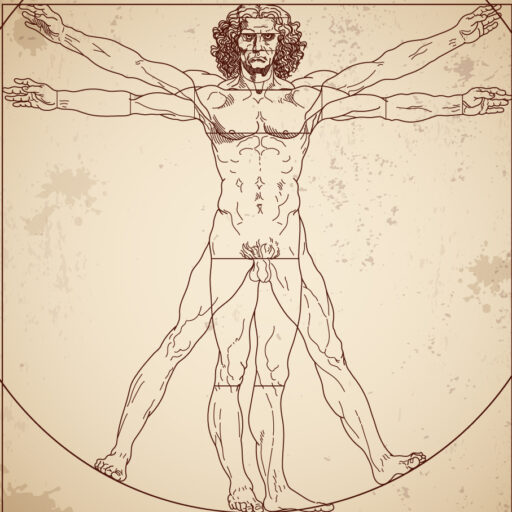
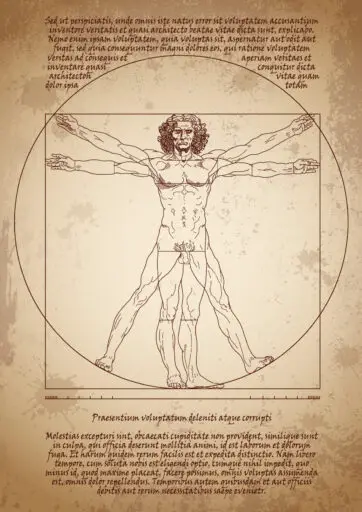
The Vitruvian Man drawing is one of Leonardo da Vinci‘s most iconic works. It represents the perfect blend of art and science.
This masterpiece showcases the ideal human proportions, as inspired by the writings of the ancient Roman architect Vitruvius.
It stands as a symbol of the Renaissance‘s dedication to exploring humanity’s connection with the universe.
Exploring this drawing offers insights into Leonardo‘s harmonious vision of geometry, anatomy, and symmetry.
You can marvel at how the male figure fits perfectly within a circle and a square, representing the harmony between humans and nature. Leonardo’s work continues to fascinate people with its blend of meticulous observation and philosophical inquiry.
Those seeking to understand the drawing’s significance must be aware of how Vitruvius’ ideas on architecture and the human body influenced Leonardo’s exploration of these themes.
The Vitruvian Man is a fundamental study of the balance between art and anatomical science. It captures the essence of the Renaissance quest for knowledge and understanding.
Leonardo da Vinci’s drawing of the Vitruvian Man is a remarkable blend of art and science. It captures human proportions with mathematical precision and artistic mastery.
Two key influences shaped this iconic artwork: da Vinci’s Renaissance environment and the teachings of the ancient Roman architect Vitruvius.
Europe experienced a revival of art, science, and culture during the Renaissance. Leonardo da Vinci epitomized this era’s spirit of discovery.
He combined artistic skill with scientific inquiry, as seen in the Vitruvian Man drawing.
This period sparked a profound interest in human anatomy, which led Da Vinci to explore the human form with unmatched detail.
Influential thinkers and artists of his time shared knowledge, fostering interdisciplinary studies.
This cultural environment significantly impacted da Vinci’s approach to his work, which combined the visual arts with empirical study.
His innovative methods offered a new perspective on art and its connection to science.
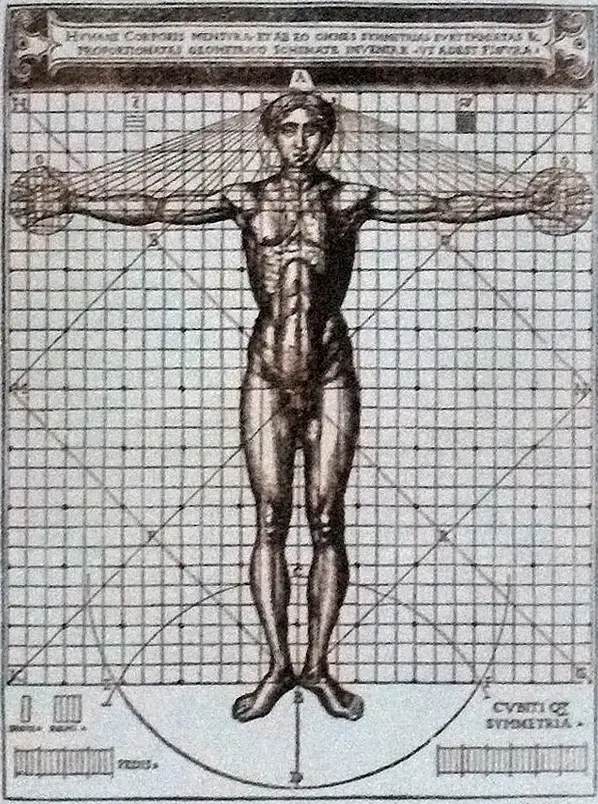
An ancient Roman architect, Vitruvius outlined principles of architecture and proportion that inspired da Vinci. His writings emphasized harmony between human dimensions and architecture.
Da Vinci applied these concepts to human anatomy in his drawing, illustrating the ideal human body proportions.
This influence is evident in the geometric forms of the Vitruvian Man drawing, where the human figure aligns with a circle and a square.
This representation showcases Vitruvius’ belief in symmetry and brings a philosophical dimension to da Vinci’s creation.
The combination of Vitruvius’ ideas with Leonardo’s artistry highlights the drawing’s significance as a fusion of art and science.
The Vitruvian Man by Leonardo da Vinci is a remarkable representation of the blend between art and science. This illustration employs geometric forms to connect the human body with the universe, revealing profound insights into Renaissance ideals.
The iconography of the Vitruvian Man showcases da Vinci’s engagement with proportion and symmetry.
This drawing perfectly fuses the principles of ancient Roman architect Vitruvius with Renaissance ideals.
It features a male figure in two superimposed positions with arms and legs apart, inscribed in a circle and a square.
This Vitruvian Man artwork becomes a potent symbol for harmony in mathematics and the universe, capturing the humanist belief that humans mirror the larger cosmos.
Leonardo’s skillful composition illustrates the unity of art and science.
He achieves balance and harmony within the drawing by using precise geometric shapes.
The two positions of the figure inside the circle and square create a dynamic visual design.
The meticulous placement of the limbs demonstrates da Vinci’s attention to detail and indicates his understanding of human anatomy and mathematical precision.
This piece’s composition makes it an enduring example of the intersection of science and art during the Renaissance era.
The proportions in the Vitruvian Man drawing reflect da Vinci’s exploration of the human form‘s mathematical dimensions.
The figure’s outstretched limbs fit perfectly within the circle and square, representing ideal human proportions.
These measurements align with Vitruvian theories and embody the Renaissance pursuit of balance and beauty.
According to Britannica, the drawing underscores the notion that the body and these shapes have a precise geometric correspondence, symbolizing physical and cosmic harmony.
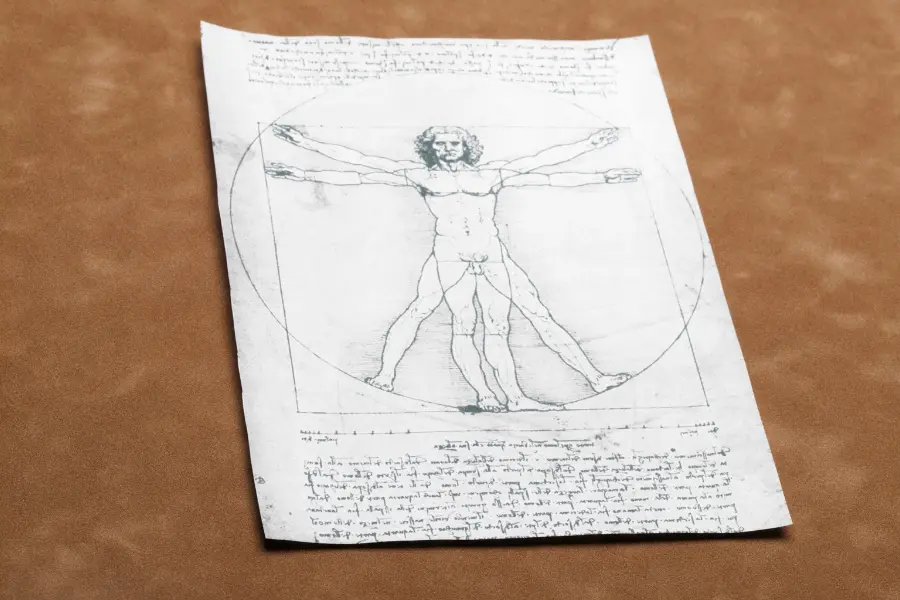
The Vitruvian Man by Leonardo da Vinci is more than an artwork; it represents the blend of art and science.
It reflects Leonardo da Vinci’s mastery of anatomy and his fascination with geometry and proportion.
Da Vinci’s Vitruvian Man drawing showcases remarkable anatomical accuracy.
At a time when the human body was often misunderstood, this drawing highlighted a detailed understanding of human anatomy.
Leonardo studied cadavers, gaining insights into muscles, bones, and skin.
The Vitruvian review demonstrates this scientific exploration, showing how the parts of the body fit together harmoniously.
His ability to combine art with detailed anatomical study set a new standard for realistic human representation, influencing artists beyond the Renaissance.
Geometry plays a crucial role in the Vitruvian Man artwork.
Da Vinci aligned the figure within a square and a circle, representing geometric symmetry, which was central to Renaissance art.
Vitruvian Man geometry illustrates the connection between human proportions and architectural principles.
This combination highlights the belief that humans reflect the universe’s structure.
It emphasizes symmetry as an ideal in art and architecture.
By doing so, Leonardo illustrates the beauty and mathematical logic inherent in nature and design.
The concept of the Golden Ratio is evident in the proportions of the Vitruvian Man.
This mathematical principle suggests a harmoniously pleasing ratio found in nature.
Leonardo’s portrayal aligns with the Golden Ratio, linking the human body to universal design principles.
The Vitruvian Man proportions display how different body parts relate to each other numerically.
This drawing serves as a visual definition of mathematical beauty, merging art, mathematics, and nature.
Through this, Leonardo demonstrated how art and science are not separate but deeply interconnected disciplines.
Leonardo da Vinci’s drawing of the Vitruvian Man has left a lasting mark on Renaissance and modern cultures. This iconic artwork symbolizes the blend of art and science and has inspired various interpretations over the centuries.
During the Renaissance, the Vitruvian Man artwork embodied the era’s fascination with human anatomy and proportions.
Artists and scholars admired how Da Vinci combined scientific accuracy with artistic expression.
The drawing’s golden ratio and geometric patterns mirrored the Renaissance pursuit of perfection.
Many artists of the time were motivated by this work to explore similar themes.
Leonardo aimed to capture the harmony between the human body and the universe by depicting a man with perfect proportions.
Thus, the drawing symbolized the Renaissance’s focus on the ideal human.
In modern times, the Vitruvian Man’s meaning has evolved beyond its initial artistic and scientific context.
Today, it represents concepts of balance and symmetry in various fields, including architecture and design.
Artists and creators continue to reinterpret this drawing, seeing it as a model of human potential and exploration.
In popular culture, the Vitruvian Man image is often used to illustrate the intersection of art, science, and philosophy.
Its iconic nature makes the drawing a recognizable reference in modern media, highlighting its timeless significance and enduring relevance.
The Vitruvian Man drawing requires careful handling to ensure its longevity. Due to its delicate nature, experts store it in a controlled environment.
Controlled levels of light and temperature help prevent damage to its fragile ink and paper.
To protect this iconic piece of Vitruvian man-art, it is rarely displayed in public. When shown, it is generally under strict supervision, using protective barriers to minimize exposure. Preventing any direct contact is crucial for most cultural institutions.
Storage Guidelines:
These measures are crucial for preserving the quality and longevity of the Vitruvian Man by Leonardo da Vinci. The balance between public display and conservation is always a challenge for curators.
Reproductions and digital formats allow people to appreciate the Vitruvian man image without risking the original. This approach supports education and preservation, ensuring the drawing remains part of cultural discussions about Vitruvian man proportions.
Institutions focus on educational efforts to explain what the Vitruvian man means and its importance in art and science. Public access doesn’t need to come at the cost of the drawing’s integrity, ensuring future generations can learn from this masterful work.
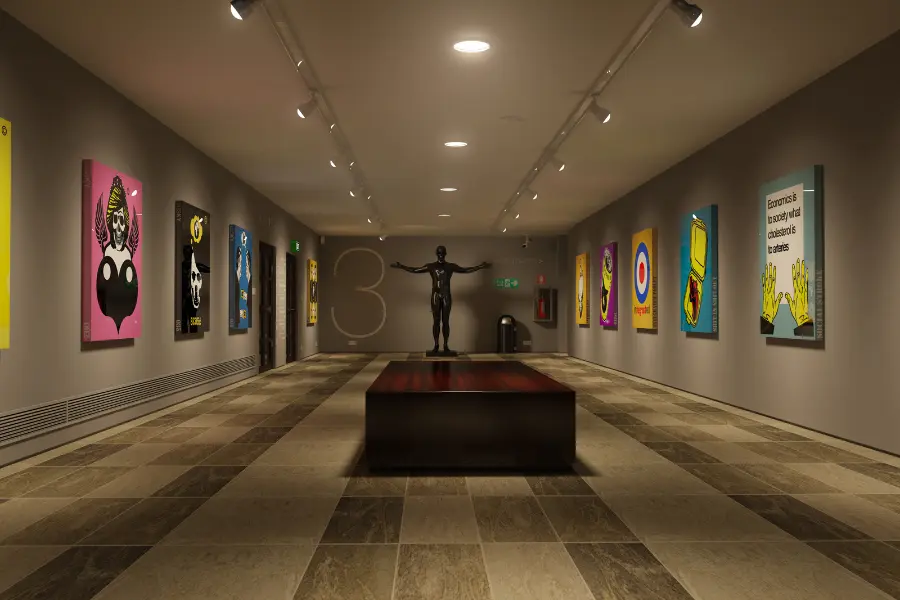
Leonardo da Vinci’s Vitruvian Man drawing is a masterpiece often cited for its depiction of ideal human proportions. Though the artwork is renowned, its exhibition history has been selective due to its delicate nature.
One of the most significant exhibitions of the Vitruvian Man was held at the Louvre in 2019, marking the 500th anniversary of Leonardo da Vinci’s death.
Although typically kept out of public view due to its fragile condition, the Gallerie dell’Accademia in Venice lent the drawing. Previously, the Vitruvian Man had been infrequently displayed, underscoring its status as a rare yet treasured piece in art history. Each exhibition offers a unique opportunity for art enthusiasts to appreciate the intricacies of da Vinci’s work.
The Vitruvian Man is generally kept out of public view to ensure its preservation. It is part of the collection at the Gallerie dell’Accademia in Venice, where careful measures are taken to protect it.
Because of its condition, the artwork is not included in regular exhibitions. Art lovers and scholars often rely on reproductions and analyses to study its proportions and meanings.
On rare display, it attracts significant public attention, demonstrating its enduring fascination and importance in understanding Renaissance art and human anatomy.
The Vitruvian Man drawing, a renowned work by Leonardo da Vinci, has sparked numerous legal and ethical debates, ranging from ownership claims to discussions about commercial rights.
Ownership disputes over the Vitruvian Man drawing often center on national heritage laws and regulations. Italy has strict rules in place to preserve its cultural heritage. It considers such art national treasures, making it difficult for private entities to assert ownership claims.
These laws have sparked debates on whether artworks in public collections can be sold on the market. The Vitruvian Man is housed in the Galleria dell’Accademia di Venezia, under Italy’s robust cultural protection. This protection elevates the artwork’s status, complicating ownership-related legal battles.
The question of who controls the image rights of the Vitruvian Man artwork presents another legal challenge. Although Leonardo da Vinci died in 1519, making the image public domain under European laws, Italy implemented additional restrictions.
For example, using the Vitruvian Man image for commercial purposes requires permissions and possibly fees.
Laws like these reflect a broader trend of governments influencing historical art. This regulation impacts everything from educational uses to commercial marketing.
Enforcement of these laws ensures revenue generation for public institutions and preserves the integrity of the drawing. Legal professionals and artists must stay informed about these evolving rights to navigate the use of such iconic images effectively.
Leonardo da Vinci’s Vitruvian Man drawing showcases impressive technical skills. Understanding the materials and how the artwork has been preserved is essential to appreciating its lasting significance.
Leonardo da Vinci created the Vitruvian Man drawing in the late 15th century using a metal point, pen, and ink, as well as watercolor on paper.
The different media allowed for precise lines and detailed shading, highlighting his mastery of art and science.
He aimed to accurately capture human proportions, inspired by the ideas of the ancient Roman architect Vitruvius.
Creating such detailed work required a deep understanding of anatomy.
Leonardo’s detailed study of the human body involved dissecting numerous corpses, which provided him with the knowledge to illustrate the perfect proportions from Vitruvius.
This dedication to precision and scientific inquiry makes this art piece remarkable in Renaissance art.
Over the centuries, the Vitruvian Man has faced challenges in preservation. Due to its age, the paper’s condition is delicate, and exposure to light can lead to further deterioration.
Institutions must carefully manage their exposure to prevent damage.
While innovative, the skilled use of metalpoint and watercolor contributes to the drawing’s fragility.
Art historians and conservationists take extraordinary measures to ensure its long-term preservation.
For instance, the drawing is usually kept in controlled environments to minimize exposure and maintain its condition.
The Vitruvian Man’s status as a vital piece of art history requires ongoing efforts to preserve its integrity. This will allow future generations to explore its mathematical and artistic significance, as da Vinci understood.
The Vitruvian Man, a famed drawing by Leonardo da Vinci, significantly impacted modern art by highlighting the connection between art and science. This drawing has shaped artistic techniques and is used in education to explore proportion and human anatomy.
The influence of the Vitruvian Man in modern art springs from its unique representation of human proportions.
Artists have drawn inspiration from this iconic image to explore symmetry and balance.
Da Vinci’s understanding of geometry and proportion inspired countless artists to integrate these concepts into their creations, resulting in more scientifically informed designs.
Modern artists often reference the Vitruvian Man to explore themes of human perfection and the relationship between humans and the universe.
This drawing serves as a cornerstone for understanding proportion, a concept evident in various art forms and installations today.
The Vitruvian Man is essential for understanding human anatomy and proportion in educational settings.
The drawing illustrates ideal human-body ratios, which have become helpful for both art students and those studying human biology.
Educational resources often incorporate the Vitruvian Man drawing to teach these principles in a straightforward manner.
Art classes analyze drawings to understand their precision, while anatomy lessons use them to juxtapose scientific data with artistic interpretation.
This dual role underscores its significance in laying the groundwork for much of what is taught about human proportions today.
The Vitruvian Man by Leonardo da Vinci is not just a drawing; it holds significant meaning in the history of art and human anatomy. This analysis explores how this piece relates to other works by da Vinci and contrasts with art from the same period.
Leonardo da Vinci often explored human anatomy in his art. The Vitruvian Man drawing is a prime example, showing detailed human body proportions.
This approach is evident in his anatomical sketches, particularly in his studies of the human skull and muscles.
In his notebooks, da Vinci combined scientific inquiry with artistry.
He used sketches to illustrate the balance between art and mathematics, echoing themes found in the artwork of the Vitruvian Man. These notebooks reveal da Vinci’s deep interest in the golden ratio, which he applied to his understanding of human proportions.
His painting, The Last Supper, also uses proportion and perspective. Both works demonstrate how da Vinci merged art with science.
The Vitruvian Man not only fits into this category but also serves as a guide on how proportions can define beauty and function.
Many artists during da Vinci’s time focused on religious themes and symbolic imagery. The Vitruvian Man diverges from this by emphasizing mathematical precision and human anatomy.
While most contemporary art highlighted divine subjects, this piece explored the earthly form of man.
Art from the Renaissance often depicted religious scenes, but da Vinci’s work took a different approach. The Vitruvian man’s meaning reflects a shift towards humanism and the study of the natural world.
Artists like Michelangelo also studied anatomy, but da Vinci’s work went beyond what was typical at the time.
In contrast, other contemporary artists focused on spiritual or mythical themes. Da Vinci, however, used his observations to understand the human figure through the principles of geometry. This combination of science and art set his work apart, establishing a standard for future generations.
The Vitruvian Man drawing remarkably represents the harmony between art and science. Leonardo da Vinci skillfully blends anatomical precision with geometric principles, reflecting his interest in human proportion and symmetry.
This drawing is an artistic endeavor and a study of the human body. It shows the influence of Vitruvius, a Roman architect who believed in the correlation between human form and architectural proportion.
Key Elements:
The Vitruvian Man is a masterpiece of the Renaissance, serving as a visual tool that bridges various fields, including art, science, and philosophy. Over the years, many scholars have praised its significance.
You can explore the link between da Vinci’s innovative ideas and his practical inventions in detail at the Leonardo da Vinci Inventions. This connection shows his multifaceted genius, which extends beyond the Vitruvian Man drawing.
The Vitruvian Man drawing is an iconic representation of human proportion and the study of geometry. It connects art and science by exploring the human body’s symmetry.
The Vitruvian Man symbolizes the harmony between human proportions and the universe. Leonardo da Vinci illustrated how the human body reflects the symmetry of the cosmos.
The hidden message explores the connection between physical realms and divine order. Da Vinci used the drawing to demonstrate the unity of art and science.
Vitruvian refers to Vitruvius, a Roman author and architect whose principles on ideal human proportions inspired da Vinci’s work.
The Vitruvian Man is based on geometric theories rather than empirical evidence. It is a conceptual illustration of ideal proportions rather than a scientific fact.
The drawing embodies mathematical precision. It uses the ratios found in ancient texts to depict ideal human proportions, combining a circle and a square.
The text accompanying the drawing refers to Vitruvius’s ideas on ideal body measurements. Da Vinci’s notes provide insights into these ancient guidelines.
Vitruvian Man was conceived to illustrate Vitruvius’s principles. It visualized how human anatomy mirrors the universe’s structural design.
A Vitruvian Man tattoo often signifies the wearer’s appreciation for the balance between art and science. It represents a pursuit of knowledge and understanding.
While “Vitruvian Woman” is not a historical artifact, it draws from the same principles of proportion. It is a modern adaptation symbolizing equality in representation.
The four arms and legs show different positions of the man’s movement. This illustrates the combination of human proportions fitting within a circle and a square.

Leonardo da Vinci was one of the greatest anatomists of all time. He dissected more than 30 human cadavers, studied every aspect of anatomy and physiology, and documented his findings with unparalleled beauty and clear imagery.
Leonardo studied anatomy to improve his drawings of the human body, but he also brought a scientist’s perspective to the discipline. Da Vinci’s early anatomical studies focused on bones and muscles, but he combined anatomy and physiology from the very beginning. Anatomists in Leonardo’s time often dissected stress-free bodies, such as drunks and tramps, whose bodies were usually male.
